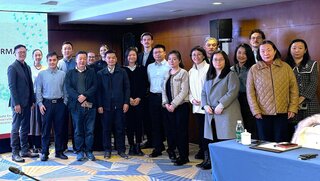Turning EVs into Grid Assets: China and Germany Exchange Vision for the Future of Vehicle-to-Grid
Exchange workshop on bidirectional charging hosted in Beijing

On 21 November 2025, the Sino-German Energy Partnership hosted a bilateral workshop on bidirectional charging in Beijing. Bringing together over 90 key stakeholders from China and Germany, the workshop provided a platform to exchange the latest developments in vehicle-to-grid business models and related benefits for the grid, foster mutual learning, and explore opportunities for deeper cooperation between both countries.
How EVs Are Becoming a Backbone of Future Energy Systems
Bidirectional charging turns EVs into mobile storage units that can feed electricity back into the grid. As EV adoption and charging infrastructure grow rapidly in Germany and China, this concept is becoming essential for improving grid stability, supporting renewables, and managing peak demand. Paired with smart charging, it offers a promising solution for building flexible and resilient energy systems.
China’s electric vehicle fleet has grown to 31.4 million, supported by over 3.5 million public charging points. More than half of all new cars sold are now electric. To tap into their grid flexibility potential, the NDRC launched a pilot program in late 2024, testing smart charging and discharging across charging stations, households, and battery swapping sites in 50 cities in China.
Germany’s electric vehicle fleet continues to grow, with 248,700 new EVs registered in the first half of 2025 and a 17.7 percent market share, supported by a network of around 160,000 public charging points. Around 166,000 vehicles are already capable of bidirectional charging, and a growing number of wall boxes and electricity tariffs now support this functionality. A range of initiatives is working to advance the use of vehicle batteries for grid applications, with a strong focus on household-based solutions.
Connecting Policies, Pilots and Practice Across Two Leading EV Markets
To address this topic, the Sino German Energy Partnership, on behalf of the German Federal Ministry for Economic Affairs and Energy (BMWE), organised a hybrid exchange workshop on bidirectional charging on 21 November in Beijing. The aim was to exchange the latest developments, foster mutual learning, and explore collaboration opportunities between China and Germany. This workshop continued a bilateral exchange first held in 2022, which focused on technical barriers, limited awareness, and the lack of viable business models. Since then, technology has progressed, pilot projects have generated valuable insights, and new business models have begun to emerge.
The event opened with a substantive exchange on policy development. NOW GmbH outlined Germany’s regulatory progress on bidirectional charging, including dynamic tariffs, wall box rules and exemptions from grid fees, while also noting persistent barriers such as limited V2G ready vehicles, interoperability challenges and the slow rollout of smart meters. The State Grid Research Institute presented China’s policy development for V2G deployment, extensive pilot programme, national standards and strong NEV market foundation, while emphasising remaining obstacles such as residential metering limitations and the need for stronger market mechanisms and user incentives to scale participation.
The second part of the event focused on practical experience sharing and application pathways. State Grid Smart IoV demonstrated how its large-scale digital platform already enables multiple V2G market services and supports plans to expand capacity, reduce equipment costs through wider AC deployment and integrate battery and mobility data. E.ON shared insights into its tariff and feed in model that financially rewards customer participation and creates revenues through intraday trading and redispatch; further work is underway to expand system compatibility beyond BMW vehicles. Huzhou Power Supply presented its AC based pilot for buses and trucks, showing that AC charging can significantly reduce costs compared to DC concepts. Fraunhofer IFAM highlighted the ecological and grid benefits of battery swapping stations, which require less charging power, offer valuable flexibility resources and are particularly effective for heavy duty transport segments with strong local grid impacts.
The following discussion centered on how China and Germany can overcome regulatory, technical and economic barriers to scaling vehicle to grid. German participants highlighted regulatory bottlenecks, while Chinese experts pointed to the value of China’s diverse pilot scenarios. German stakeholders expressed strong interest in learning from China’s large-scale demonstrations, data management, and heavy-duty use cases. Chinese counterparts emphasised Germany’s strength in household-level applications. Participants also discussed battery health impacts, warranty constraints and cost-reducing solutions. They underscored the influence of differing tariff systems and stressed the importance of transparent pilot data to support wider replication.
Following this exchange, the Energy Partnership will identify relevant mutual learning opportunities - such as swapping stations, public versus residential charging deployment, and black-start applications, which were already untapped during the dialogue - and continue deepening the dialogue with stakeholders in both countries. If you are interested in engaging in this topic, please contact Vincent Fremery (vincent.fremery(at)giz.de).